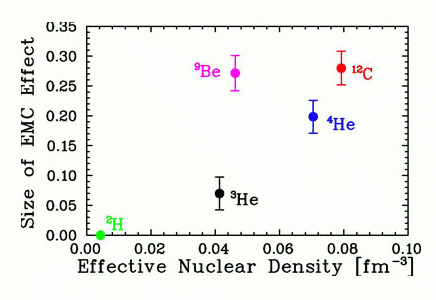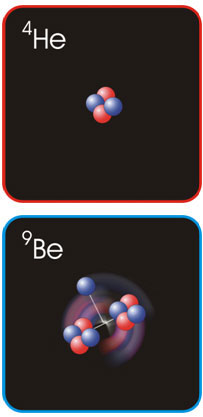Nuclear Dependence of the EMC Effect

Slope of the isoscalar EMC ratios for 0.35 < x < 0.7 as a function of scaled nuclear density as calculated using GFMC of spatial distributions as described in Ref [1] . A clear breakdown of the simple density dependence model for the EMC effect for 9Be is observed.
Additional Links
Protons and neutrons are complex bound states of quarks and gluons, held together by the strong interactions of quantum chromo dynamics (QCD). Their structure may be modified inside of the dense environment of a nucleus, and such modification of hadron properties in the nuclear environment is of fundamental importance in understanding QCD. Measurements of deep inelastic scattering in nuclei show that the quark distributions in heavy nuclei are not simply the sum of the quark distributions of the constituent protons and neutron, as one might expect for a weakly bound system.
Despite much theoretical work, no unique and universally accepted explanation of this difference, known as the “EMC effect”, has emerged. The nuclear effects come in part from binding and Fermi motion mechanisms with possible internal modifications of the nucleon. Many models of the EMC effect predict that it depends on the mass or density of the parent nucleus, but previous data, focusing mainly on heavier nuclei, could not determine if the EMC effect scales with mass or density. A detailed experimental study [1, 2] was performed in Hall C to test these predictions on a variety of light nuclei.
Figure 1 shows the magnitude of the EMC effect as a function of average nuclear density. The difference between 3He and 4He is much larger than predicted by an A-dependent fit from a previous experiment at SLAC, while the large EMC effect in 9Be is at odds with a density-dependent parameterization. A likely explanation is the unusual structure of 9Be, with two orbiting alpha-like clusters with an additional neutron as shown in Figure 2. The orbiting clusters yield a large radius but most of the protons and neutrons are contained within the high local densities of the clusters. Thus, the observed nuclear dependence suggests that the local environment of the nucleons may be driving the nuclear modification. Plans are being made to test this hypothesis with the 12 GeV upgrade of Jefferson Lab by including a more complete set of light nuclei.
References:
J. Seely, et al., Phys. Rev. Lett. 103 (2009) 202301


